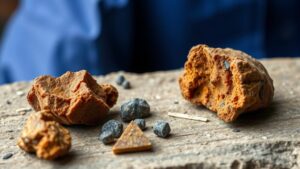Maximizing Ore Recovery by Optimizing Milling Techniques
Maximizing Ore Recovery by Optimizing Milling Techniques
Effective ore recovery is vital for the profitability of mining operations. The milling process, which involves crushing and grinding ore to liberate valuable minerals, plays a crucial role in determining the efficiency of this recovery. By optimizing milling techniques, mining companies can significantly enhance mineral extraction rates and reduce operational costs. This article delves into key strategies for optimizing milling processes to maximize ore recovery.
Understanding the Milling Process
The milling process consists of several stages, including crushing, grinding, and classification. Each stage is designed to reduce the size of the ore and separate valuable minerals from waste materials, known as gangue. The objective is to produce a finely ground product that maximizes the surface area available for subsequent recovery methods, such as flotation or leaching.
- Crushing: This initial stage breaks down ore into smaller fragments, typically utilizing jaw crushers or cone crushers.
- Grinding: Once crushed, the ore is further reduced in size using mills, such as ball mills or rod mills, to achieve the desired particle size.
Proper optimization of each of these stages can lead to improved ore recovery rates and more efficient processing overall.
Factors Affecting Milling Efficiency
Several factors can influence the efficiency of the milling process, including:
- Ore Characteristics: The physical and chemical properties of the ore can affect how it reacts during milling. For example, harder ores may require additional energy and time during the crushing and grinding phases.
- Grinding Media: The choice of grinding media (e.g., steel balls, rods) can impact the milling performance. Selecting the right size and material can enhance breakage rates and improve recovery.
- Energy Consumption: Milling requires significant energy. Efficient milling techniques reduce energy costs while maintaining or enhancing recovery rates.
- Water Usage: Optimal water addition is critical for the grinding process, as too much or too little can hinder recovery and increase operational costs.
Optimizing Milling Techniques
Optimizing milling techniques involves a combination of equipment selection, process adjustments, and innovative technologies. Here are some established and emerging practices:
1. Selection of Equipment
The choice of milling equipment is essential. For example, using high-efficiency classifiers can significantly improve separation accuracy and reduce the amount of energy consumed. Also, advanced grinding technologies, such as vertical roller mills, can provide more efficient size reduction compared to traditional ball mills.
2. Process Automation and Control
Modern mining operations increasingly rely on automation systems to optimize milling processes. Automated control systems can monitor and adjust parameters such as feed rate, water addition, and grinding duration in real-time, thus enhancing milling efficiency and ore recovery. For example, SMC Testing has provided tools to optimize the energy consumption of milling by incorporating real-time feedback loops.
3. Particle Size Distribution
Employing techniques to ensure optimal particle size distribution (PSD) is crucial for maximizing recovery. An uneven PSD can lead to poor recovery rates. Utilizing advanced measurement technologies, such as laser diffraction, allows for precise control over PSD, leading to improved recovery yields.
4. Fine Grinding Techniques
Fine grinding techniques, such as using stirred media mills, can liberate minerals that are locked within finer particles, enhancing overall recovery. A case study from a gold mining operation in Australia demonstrated that implementing fine grinding techniques increased gold recovery by 15%, underscoring the importance of this approach.
Real-World Applications and Case Studies
Several mining companies have successfully implemented optimized milling techniques, resulting in significant improvements in ore recovery.
- Example 1: A copper mine in Chile adopted integrated process optimization, focusing on energy-efficient milling. This change resulted in a 20% increase in recovery and a 30% reduction in energy costs.
- Example 2: In South Africa, a platinum mine utilized advanced measurement technologies for real-time monitoring of particle size. This adjustment increased the recovery rate from 85% to 90%, demonstrating the effectiveness of optimized milling strategies.
Actionable Takeaways
Mining companies looking to enhance ore recovery should consider the following actionable steps:
- Conduct thorough assessments of ore characteristics to tailor milling processes accordingly.
- Invest in high-efficiency milling equipment and automation systems for greater process control.
- Use regular monitoring of particle size distribution to ensure optimal milling conditions.
- Explore innovative milling techniques, including fine grinding, to unlock further recovery potential.
By strategically optimizing milling techniques, mining operations can not only maximize ore recovery but also improve operational efficiency and reduce costs, ensuring long-term sustainability and profitability in an increasingly competitive market.



